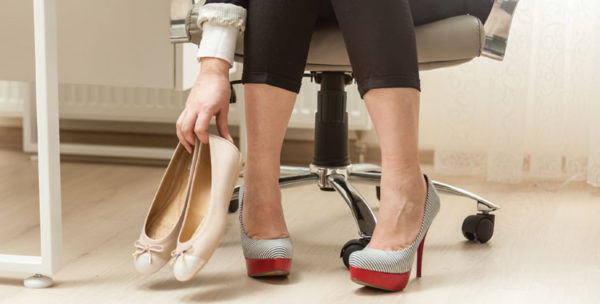The Effects of High Heels on Your Feet
by BusinessWoman magazine / 0 Comments / 2400 View / March 30, 2018
Women have been wearing various kinds of high heels for centuries. Millions of women worldwide wear high heels on a daily basis. They are very popular and often considered a fashion statement. Every major department store has a huge selection to choose from.
Studies have shown most women have pain within an hour of wearing heels, and 90 percent of women have foot issues from poorly fitted shoes. However, most tolerate this discomfort to look taller, more stylish, and even professional.
Researchers have discovered that wearing high heels, even for a relatively short period of time, can have major effects on your spine, hips, knees, ankles, and feet, while altering your posture and gait.
When standing in high heels, the body’s center of gravity is shifted forward. Your body will make postural adjustments from the toes all the way to the spine in order to gain balance.
When standing without footwear, both the heel and toes rest flat on the floor. At this point, the body weight is supported by the arch of the foot and distributed equally between the forefoot and hindfoot.

Joseph P. Hensley, D.P.M., is a podiatrist, or Doctor of Podiatric Medicine, with OSS Health.
High heels shift the body weight away from the heel to the balls of the foot. Ninety percent of the body’s weight is then redistributed and supported by the metatarsal heads of the forefoot, the area of the foot just before the toes. The higher the heel, the greater pressure on the ball of your foot. A 3-inch heel, for example, exerts about 76 percent more pressure than a flat shoe.
The impact of high heels on the forefoot is compounded by the cramped toe box associated with high heels. Forcing the toes into a small toe box places a great deal of pressure on the ball of the foot.
Over time, high heels or any type of shoe with a narrow or pointy toe box can cause or worsen many foot problems. This would include bunions, hammertoes, heel pain, shortened Achilles tendon, corn and callous formation, ingrown toenails, and neuroma or pinched nerves. In fact, women account for the majority of operations performed each year for bunions, hammertoes, and trapped nerves due to their choice of footwear.
Wearing high heels can strain your ankles, along with other tendons surrounding the foot, which can lead to tendonitis. Due to foot elevation and weight shifting forward, a lot of tension gets taken off of the Achilles tendon, and that causes it to shorten over time.
Typically, the higher the heel you wear, the shorter the Achilles tendon will become. In less than six months, this can cause measurable changes to the length of the tendon and muscles.
That is the reason many women don’t feel good in flats: The tendons are so tight from years of wearing high heels. Walking barefoot or in low-heel shoes becomes painful as the shortened tendon and calf muscles are stretched.
By limiting the natural motion of the foot during walking, high heels have a dramatic effect on the knee joint. The higher the heel, the greater the impact is on the knee and other joints.
Compared to walking barefoot, high heels alter the weight distribution and increase the pressure on the inside of the knee. Over time, this increased pressure on the knee can lead to osteoarthritis. This is the most common form of arthritis and is twice as common in women.
Similarly, high heels can cause the lower back to go out of alignment. If high heels are worn on a regular basis, the spine’s ability to absorb shock can cause continued back pain. High heels also compress the vertebrae of the lower back and cause overuse of its muscles.
This is not to say that high heels should never be worn. If worn occasionally, they will not cause serious problems. However, to avoid long-term problems as mentioned above, high heels should not be worn every day.
Here are some tips for buying and wearing high heels to keep any damage they may cause to a minimum:
• Shop for shoes toward the end of the day, when your feet may have swelled.
• Have both of your feet measured; one foot may be larger or wider than the other. Buy the size that fits the larger foot.
• Stand and walk around in the shoes; find shoes that fit from the start.
• Trust your comfort rather than a shoe size; sizes vary from one manufacturer to another.
• Limit your use of high heels and wear comfortable shoes whenever possible.
• Stretch your calves and feet when you take your heels off for the day.
• As a rule of thumb, go with a wider, wedge-style heel, not more than 2 inches high, over a stiletto.
No matter what type of shoe you wear, if you are suffering from any kind of pain or discomfort in your feet, it’s probably a good idea to contact your local podiatrist for an evaluation.
Joseph P. Hensley, D.P.M., is a podiatrist, or Doctor of Podiatric Medicine, with OSS Health. Hensley specializes in the diagnosis and treatment of foot and ankle conditions, offering his patients both surgical and non-surgical treatment options. www.osshealth.com


Your Commment
You must be logged in to post a comment.